Bompani BOLT945-E User Manual
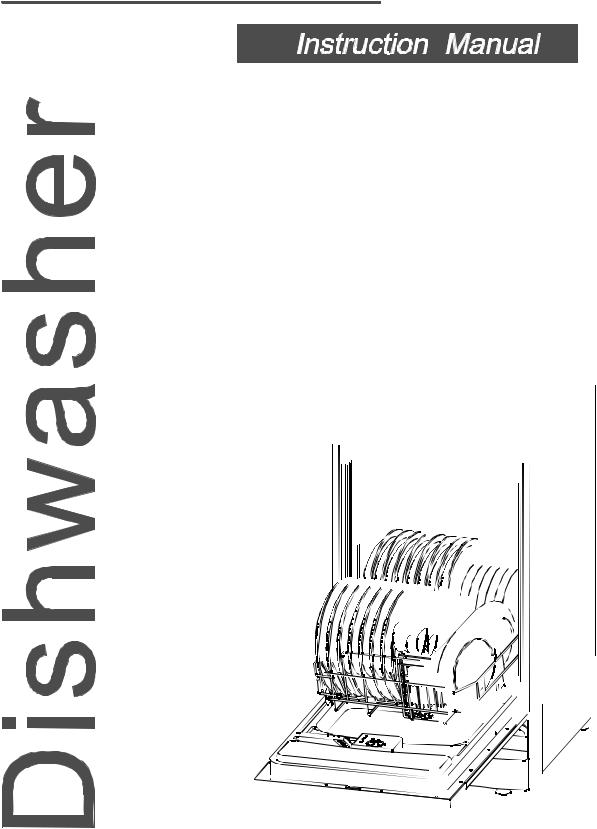
BOLT945/E
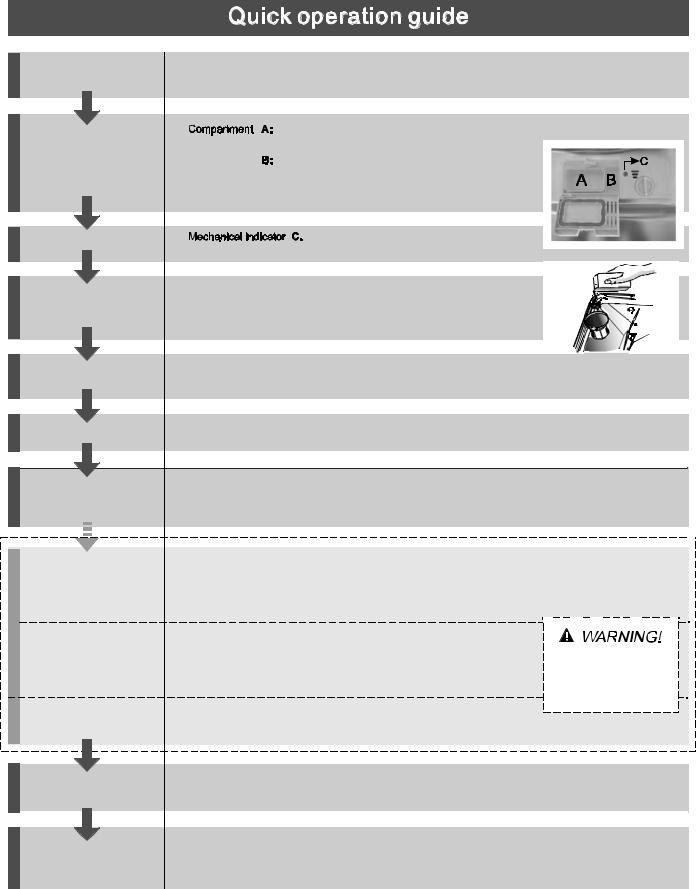
For detailed operating method read the corresponding content on the instruction manual.
Switch on the appliance
Fill the detergent dispenser
Check the rinse aid level
Check the regeneration salt level
Load the baskets
Select a programme
Running the dishwasher
 Changing the programme
Changing the programme
 Add forgotten dishes in the dishwasher.
Add forgotten dishes in the dishwasher.
 If the appliance is switched off during a wash cycle.
If the appliance is switched off during a wash cycle.
Switch off the appliance
Turn off the water tap, unload the baskets
Press the On/Off button to switch on the appliance, Open the door.
With each wash cycle.
Compartment
For programmes with pre-wash only. (Follow the user instructions!)
Electric indicator on control panel (if provided).
(On models with water softener system only.) Electric indicator on control panel (if provided).
If there is no salt warning light in the control panel
(for some models), you can estimate when to fill the salt into the softener by the number of cycles the dishwasher has run.
Scrape off any large amount of leftover food. Soften remnants of burnt food in pans, then load the baskets. Refer to the dishwasher loading instructions.
Press the Programme button until the selected programme lights up. ( See the section entitled“Operationg instruction”)
Close the door, t urn on the water tap. The machine will start working after about 10 seconds.
 1. A running cycle can only be modified if it has been running for a short time. Otherwise the detergent
1. A running cycle can only be modified if it has been running for a short time. Otherwise the detergent
may have already been released and the water already drained. If this is the case, the detergent dispenser must be refilled.
2.Open the door a little to stop the washing, then press the Program button for more than 3 seconds to cancel the running programme.
3.Select a new programme, then close the door. The machine will restart after about 10 seconds.
 1.Open the door a little to stop the dishwasher.
1.Open the door a little to stop the dishwasher.
2.After the spray arms stop working, you can open the door completely. 3.Add the forgotten dishes.
4.Close the door, the dishwasher will start running again after 10 seconds.
 If the appliance is switched off during a wash cycle, when switched
If the appliance is switched off during a wash cycle, when switched
on again, please re-select the washing cycle and operate the dishwasher according to the original Power-on state ).
Open the door carefully. Hot steam may escape when the door is opened!
When the working cycle has finished, the buzzer of the dishwasher will sound 8 times, then stop.
Turn off the appliance using the ON/OFF button.
Warning: wait a few minutes (about 15 minutes) before unloading the dishwasher to avoid handling
the dishes and utensils while they are still hot and more susceptible to break. They will also dry better.Unload the appliance, starting from the lower basket.

Dear Customer,
 This appliance is intended to be used in household and similar applications such as:
This appliance is intended to be used in household and similar applications such as:
-staff kitchen areas in shops, offices and other working environments;
-farm houses;
-by clients in hotels, motels and other residential type environments;
-bed and breakfast type environments.
 Please carefully read this manual before using the dishwasher, it will help you to use and maintain the dishwasher properly.
Please carefully read this manual before using the dishwasher, it will help you to use and maintain the dishwasher properly.
 Keep it to refer to it at a later date.
Keep it to refer to it at a later date.
 Pass it on to any subsequent owner of the appliance.
Pass it on to any subsequent owner of the appliance.
This manual contains sections on safety Instructions, Operating Instructions, Installation Instructions and Troubleshooting Tips, etc.
 To review the section on troubleshooting Tips will help you to solve some common problems by yourself .
To review the section on troubleshooting Tips will help you to solve some common problems by yourself .
 If you can not solve the problems by yourself , please ask for the help of professional technicians.
If you can not solve the problems by yourself , please ask for the help of professional technicians.
The manufacturer, following a policy of constant development and updating of the product, may make modifications without giving prior notice.
Control Panel................................................... |
3 |
Dishwasher Features.................................... ... |
3 |
A Water Softener........................................... |
4 |
B Loading the Salt into the Softener................. |
5 |
C Fill the Rinse Aid Dispenser......................... |
5 |
D Function of Detergent ................................. |
6 |
Attention before or after loading the Dishwasher |
|
Baskets.......................................................... |
9 |
Loading the upper Basket............................... |
10 |
Loading the Lower Basket............................... |
10 |
The recommended method loading big |
|
dishware.................................................... ... |
11 |
Cutlery Basket........................................... ... |
12 |
Wash Cycle Table........................................... |
13 |
Turning on the Appliance................................ |
14 |
Change the Programme.................................. |
14 |
At the End of the Wash Cycle........................... |
14 |
Filtering System............................................. |
15 |
Caring for the Dishwasher............................... |
16 |
Installation preparation.................................. |
17 |
Aesthetic panel's dimensions and installation... |
18 |
Tension adjustment of the door spring.............. |
20 |
Connection of drain hoses.............................. |
20 |
Dishwasher installation steps......................... |
21 |
About Electricity Connecting........................... |
22 |
Cold Water Connection.................................. |
23 |
Before calling for service................................. |
24 |
Error codes................................................... |
25 |
Technical information..................................... |
26 |
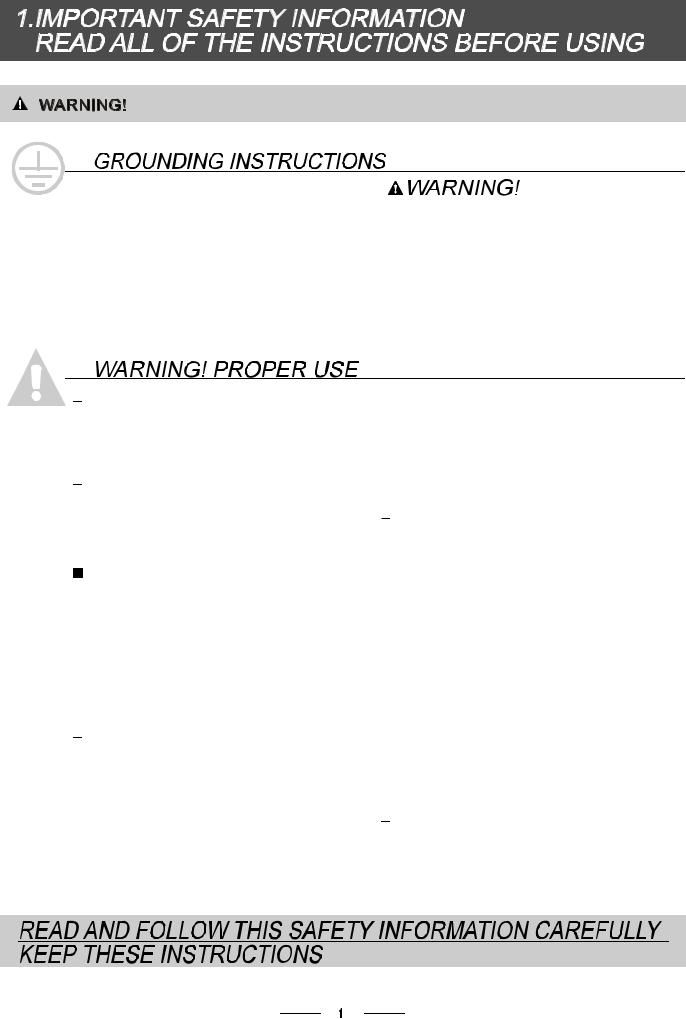
When using your dishwasher, follow the precautions listed below:

 This appliance must be grounded. In the event of a malfunction or breakdown, grounding will reduce the risk of anelectric shock by providing a path of least resistance of electric current. This appliance is equipped with a cord having an equipmentgrounding conductor and a grounding plug.
This appliance must be grounded. In the event of a malfunction or breakdown, grounding will reduce the risk of anelectric shock by providing a path of least resistance of electric current. This appliance is equipped with a cord having an equipmentgrounding conductor and a grounding plug.

 The plug must be plugged into an appropriate outlet that is installed and grounded in accordance with all local codes and ordinances.
The plug must be plugged into an appropriate outlet that is installed and grounded in accordance with all local codes and ordinances.
 Improper connection of the equipment-grounding conductor can result in the risk of an electric shock.
Improper connection of the equipment-grounding conductor can result in the risk of an electric shock. 
 Check with a qualified electrician or service representative if you are in doubt whether the appliance is properly grounded. Do not modify the plug provided with the appliance; If it does not fit the outlet. Have a proper outlet installed by a qualified electrician.
Check with a qualified electrician or service representative if you are in doubt whether the appliance is properly grounded. Do not modify the plug provided with the appliance; If it does not fit the outlet. Have a proper outlet installed by a qualified electrician.

 Do not abuse, sit on, or stand on the door or dish rack of the dishwasher.
Do not abuse, sit on, or stand on the door or dish rack of the dishwasher.

 Do not touch the heating element during or immediately after use.
Do not touch the heating element during or immediately after use.
(This instruction is only applicable to machines with a visual heating element.)

 Do not operate your dishwasher unless all enclosure panels are properly in place. Open the door very carefully if the dishwasher is operating, there is a risk of water squirting out.
Do not operate your dishwasher unless all enclosure panels are properly in place. Open the door very carefully if the dishwasher is operating, there is a risk of water squirting out.

 Do not place any heavy objects on or stand on the door when it is open. The appliance could tip
Do not place any heavy objects on or stand on the door when it is open. The appliance could tip
forward.
When loading items to be washed:
1)Locate sharp items so that they are not likely to damage the door seal;
2) Warning: Knives and other utensils with sharp points must be loaded in the basket with their points down or placed in a
horizontal position.

 When using your dishwasher, you should prevent plastic items from coming into contact with the heating element.(This instruction is only applicable to machines with a visual heating element.)
When using your dishwasher, you should prevent plastic items from coming into contact with the heating element.(This instruction is only applicable to machines with a visual heating element.)

 Check that the detergent comparment is empty after completion of the wash cycle.
Check that the detergent comparment is empty after completion of the wash cycle.

 Do not wash plastic items unless they are marked dishwasher safe or the equivalent. For plastic items not so marked, check the manufacturer's recommendations.
Do not wash plastic items unless they are marked dishwasher safe or the equivalent. For plastic items not so marked, check the manufacturer's recommendations.
 Use only detergent and rinse additives designed for an automatic dishwasher.
Use only detergent and rinse additives designed for an automatic dishwasher. 
 Never use soap, laundry detergent, or hand washing detergent in your dishwasher. Keep these products out of the reach of children.
Never use soap, laundry detergent, or hand washing detergent in your dishwasher. Keep these products out of the reach of children.

 Keep children away from detergent and rinse aid, keep children away from the open door of the dishwasher, there could still be some detergent left inside.
Keep children away from detergent and rinse aid, keep children away from the open door of the dishwasher, there could still be some detergent left inside.

 This appliance is not intended for use by persons (including children )with reduced physical, sensory or mental capabilities, or lack of experience and knowledge ,unless they have been given supervision or instruction concerning use of the appliance by a person responsible for their safety.
This appliance is not intended for use by persons (including children )with reduced physical, sensory or mental capabilities, or lack of experience and knowledge ,unless they have been given supervision or instruction concerning use of the appliance by a person responsible for their safety.

 Children should be supervised to ensure that they do not play with the appliance.
Children should be supervised to ensure that they do not play with the appliance.

 Dishwasher detergents are strongly alkaline, they can be extremely dangerous if swallowed. Avoid contact with skin and eyes and keep children away from the dishwasher when the door is open.
Dishwasher detergents are strongly alkaline, they can be extremely dangerous if swallowed. Avoid contact with skin and eyes and keep children away from the dishwasher when the door is open.

 The door should not be left open,
The door should not be left open,
since this could increase the risk of tripping.

 If the supply cord is damaged, it must be replaced by the manufacturer or its service agent or a
If the supply cord is damaged, it must be replaced by the manufacturer or its service agent or a
similarly qualified person in order to avoid a hazard.

 Remove the door to the washing compartment when removing an old dishwasher from service or discarding it.
Remove the door to the washing compartment when removing an old dishwasher from service or discarding it.

 Please dispose of packing materials properly.
Please dispose of packing materials properly.

 Use the dishwasher only for its intended function.
Use the dishwasher only for its intended function.

 During installation, the power supply must not
During installation, the power supply must not
be excessively or dangerously bent or flattened.
Do not tamper with controls.

 The appliance is to be connected to the water mains using new hose sets and that old hose-sets
The appliance is to be connected to the water mains using new hose sets and that old hose-sets
should not be reused.

 The maximum number of place settings to be
The maximum number of place settings to be
washed is 9.

 The maximum permissible inlet water pressure is
The maximum permissible inlet water pressure is
1MPa.

 The minimum permissible inlet water pressure is 0.04MPa.
The minimum permissible inlet water pressure is 0.04MPa.

Dispose of the dishwasher packaging material correctly. All packaging materials can be recycled.
Plastic parts are marked with the standard international abbreviations:
|
PE |
|
|
|
|
for polyethylene, e.g. sheet wrapping material |
||
|
|
|
|
|
||||
|
PS |
|
|
|
|
for polystyrene, e.g. padding material |
||
|
|
|
|
|
||||
|
POM |
|
polyoxymethylene, e.g. plastic clips |
|||||
|
|
|||||||
|
PP |
|
|
polypropylene, e.g. Salt filler |
||||
|
||||||||
|
|
|
||||||
|
ABS |
|
Acrylonitrile Butadiene Styrene, e.g. Control Panel . |
|||||
|
||||||||
|
|
|||||||
|
|
|
|
|
|
|
|
|
|
|
|
|
|
|
|
|
|
|
|
|
|
|
|
|
|
|
|
|
|
|
|
|
|
|
|
Packaging material could be dangerous for children!
For disposing of package and the appliance please go to a recycling centre. Therefore cut off the power supply cable and make the door closing device unusable.
Cardboard packaging is manufactured from recycled paper and should be disposed in the waste paper collection for recycling.
By ensuring this product is disposed of correctly, you will help prevent potential negative consequences for the environment and human health, which could otherwise be caused by inappropriate waste handling of this product.
For more detailed information about recycling of this product, please contact your local city office and your household waste disposal service.
DISPOSAL: Do not dispose this product as unsorted municipal waste. Collection of such waste separately for special treatment is necessary.
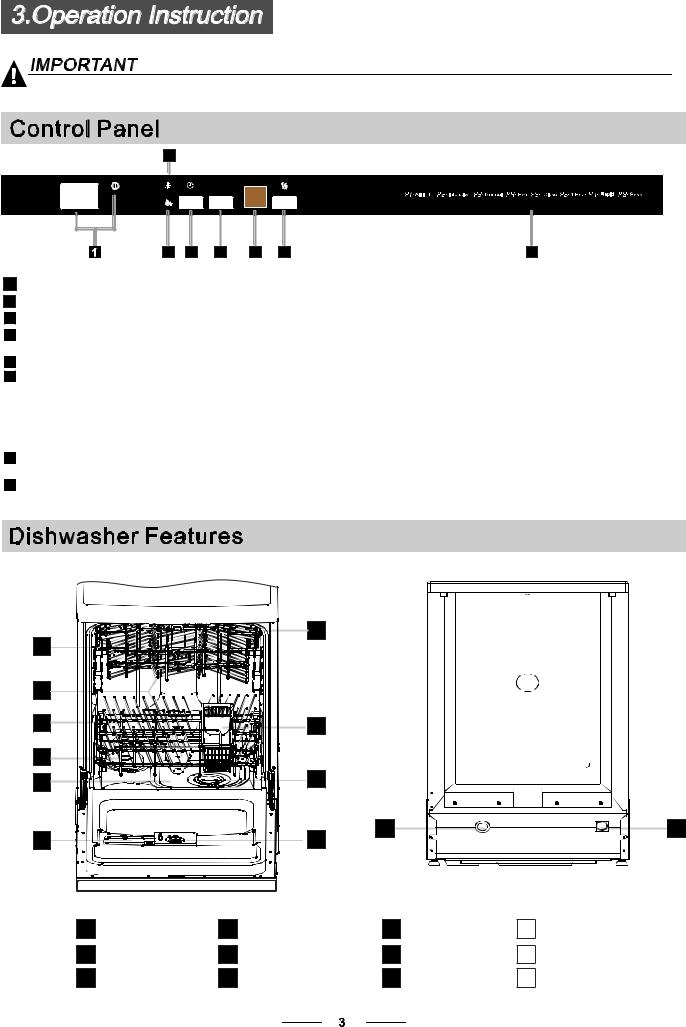
To get the best performance from your dishwasher, read all operating instructions
before using it for the first time.
3
P |
1
2
3
43
53
63
73
83
2 |
4 |
5 |
6 |
7 |
8 |
Power indicator light and switch: To turn on/off and show the power supply. Salt warning light: To show when the salt container need to be refilled. Rinse aid warning light: To show when the dispenser need to be refilled.
Delayed Start Button: To preset the wash timer and delay the starting time to 24 hours. Every press of this button increases the time by one hour. for example: one press for an hour, two for two hours... ... Program button: To select one of the 8 programs.
Display window: To show the delay time, Error codes and the selected program which shown as P1, P2 etc.
P1: All in 1 |
P5: Glass |
P2: Intensive |
P6: 1 hour |
P3: Normal |
P7: Rapid |
P4: Eco |
P8: Soak |
Half load function button and indicator light: To select and show Half load functions.
The 1 / 2 function is option.
Program show: Show the program that P1,P2 etc mean for.
|
Front view |
|
1 |
7 |
|
|
|
|
2 |
|
|
3 |
8 |
|
4 |
9 |
|
5 |
|
|
6 |
10 |
11 |
|
on |
Off |
Back View
12

1
2
3
Upper Basket
Spray Arms
Lower Basket
4
5
6
Salt Container
Main Filter
Detergent Dispenser
7
8
9
Cup Shelf |
10 |
|
Rinse Aid Dispenser |
|
|
|
|
Cutlery Basket |
11 |
Drain pipe connector |
|
|
|
|
|
Coarse Filter |
12 |
Inlet pipe connector |

Before using your dishwasher for the first time:
A.Set the water softener
B. Add 1.5Kg dishwasher salt and then full fill the salt container with water
C.Fill the rinse aid dispenser
D.Fill in detergent
The water softener must be set manually, using the water hardness dial.
The water softener is designed to remove minerals and salts from the water, which would have a detrimental or adverse effect on the operation of the appliance. The higher the
content of these minerals and salts, the harder your water is. The softener should be adjusted according to the hardness of the water in your area. Your local Water Authority can advise you on the hardness of the water in your area.
Adjusting Salt Consumption
The dishwasher is designed to allow for adjustment in the amount of salt consumed based on the hardness of the water used. This is intended to optimise and customise the level o f salt consumption.
Please follow the steps below for adjustment in salt consumption.
1. Unscrew the cap from the salt container.
2. There is a ring on the container with an arrow on it (see figure
on the side), if necessary, rotate the ring in the anticlockwise direction from the "-" Setting toward the "+" sign, based on the hardness of the water being used.
It is recommended that adjustments should be made in accordance with the following scheme:
|
WATER HARDNESS |
|
|
Salt consumption |
Auto nomy |
||
|
|
|
|
Selector Position |
|||
dH |
fH |
Clarke |
mmol/l |
(gram/cycle) |
(cycles/1kgs) |
||
|
|||||||
|
|
|
|||||
0~8 |
0~14 |
0~10 |
0~1.4 |
/ |
0 |
/ |
|
8~22 |
14~39 |
10~28 |
1.4~3.9 |
- |
20 |
50 |
|
22~45 |
39~80 |
28~56 |
3.9~8 |
Mid |
40 |
25 |
|
45~60 |
80~107 |
56~75 |
8~11 |
+ |
60 |
16 |
|
° |
° |
° |
|
|
dH=1.25 Clarke=1.78 |
fH=0.178mmol/l |
"/" |
No salt need added |
|
|
|
|
||
°DH: |
German degree |
|
"-" |
Setting toward the"-" sign |
°fH: |
French degree |
|
"+" |
Setting toward the"+" sign |
|
|
Setting toward between |
||
°Clark: British degree |
"Mid" |
the "-" sign and "+" sign |
|
||
|
|
Contact your local water board for information on the hardness of your water supply.
If your model does not have any water softener, you may skip this section.
WATER SOFTENER
The hardness of the water varies from place to place. If hard water is used in the dishwasher, deposits will form on the dishes and utensils.
The appliance is equipped with a special softener that uses a salt container specifically designed to eliminate lime and minerals from the water.
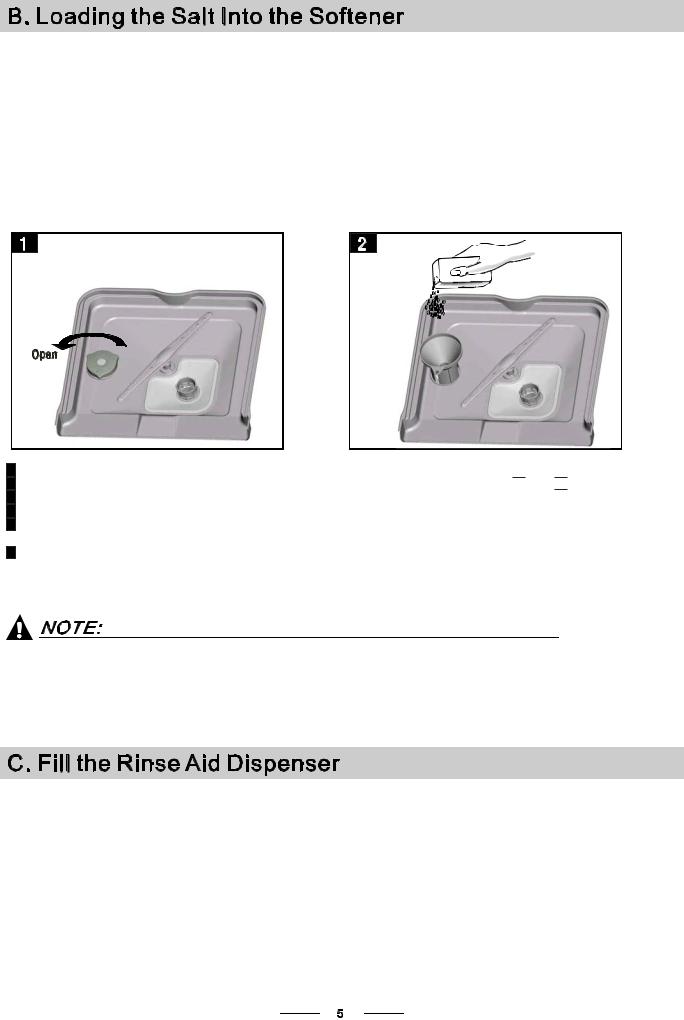
Always use the salt intended for use with dishwasher.
The salt container is located beneath the lower basket and should be filled as explained in the following:
Attention!
 Only use salt specifically designed for the use in dishwashers! Every other type of salt not specifically designed for the use in a dishwasher, especially table salt, will damage the water softener. In case of damages caused by the use of unsuitable
Only use salt specifically designed for the use in dishwashers! Every other type of salt not specifically designed for the use in a dishwasher, especially table salt, will damage the water softener. In case of damages caused by the use of unsuitable
salt the manufacturer does not give any warranty nor is liable for any damages caused.
 Only fill with salt just before starting one of the complete washing programs. This will prevent any grains of salt or salty water, which may have been spilled, remaining on the bottom of the machine for any period of time, which may cause corrosion.
Only fill with salt just before starting one of the complete washing programs. This will prevent any grains of salt or salty water, which may have been spilled, remaining on the bottom of the machine for any period of time, which may cause corrosion.
ARemove the lower basket and then unscrew and remove the cap from the salt container. 


BPlace the end of the funnel(supplied) into the hole and introduce about 1.5kg of dishwasher salt.


CFull fill the salt container with water.It is normal for a small amount of water to come out of the salt container.
DAfter filling the container , screw the cap tightly back clockwise.
EUsually, the salt warning light will stop being illuminated within 2-6 days after the salt container has been filled with salt.
FImmediately after filling the salt into the salt container, a washing program should be started (We suggest to use the soak or rapid program). Otherwise the filter system, pump or other important parts of the machine may be damaged by salty water. This is out of warranty.
1.The salt container must only be refilled when the salt warning light in the control panel comes on. Depending on how well the salt dissolves, the salt warning light may still be on even though the
salt container is filled.
If there is no salt warning light in the control panel (for some Models),you can estimate when to fill the salt into the softener by the cycles that the dishwasher has run.
2. If there are spills of the salt, a soak or a rapid program should be run to remove the excessive salt.
Rinse Aid Dispenser
The rinse aid is released during the final rinse to prevent water from forming droplets on your dishes, which can leave spots and streaks. It also improves drying by allowing water to roll off the dishes. Your dishwasher is designed to use liquid rinse aids. The rinse aid dispenser is located inside the door next to the detergent dispenser. To fill the dispenser, open the cap and pour the rinse aid into the dispenser until the level indicator turns completely black. The volume of the rinse aid container is about 110ml.
Function of Rinse Aid
Rinse aid is automatically added during the last rinse, ensuring thorough rinsing, and spot and streak free drying.
Attention!
Only use branded rinse aid for dishwasher. Never fill the rinse aid dispenser with any other substances (e.g. Dishwasher cleaning agent, liquid detergent). This would damage the appliance.
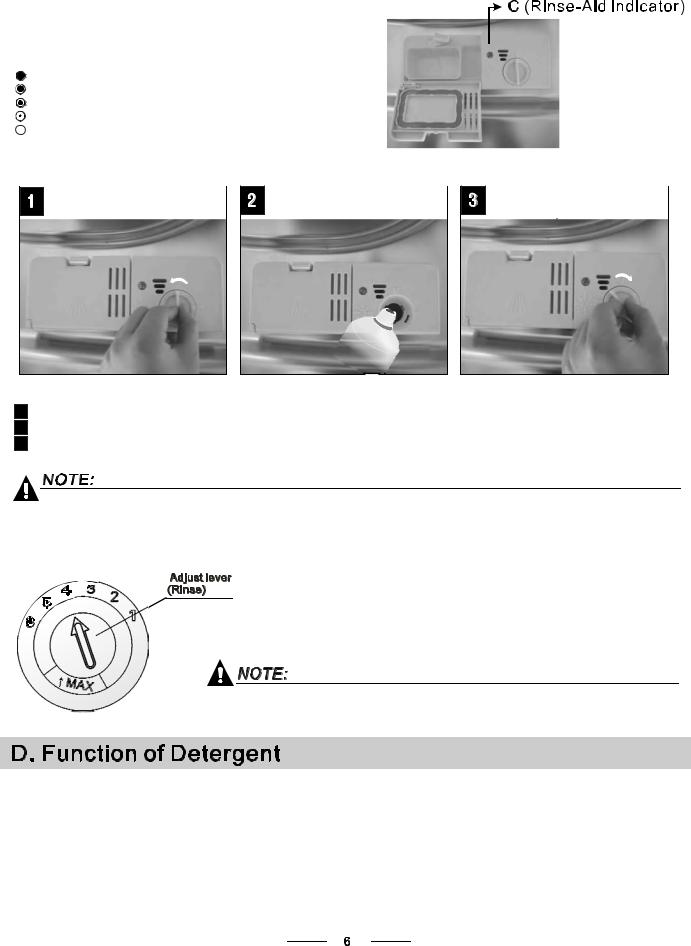
When to Refill the Rinse Aid Dispenser
If there is no rinse-aid warning light in the control panel, you can estimate the amount from the colour of the optical level indicator "C "located next to the cap. When the rinse-aid container is full, the whole
indicator will be dark .As the rinse-aid diminishes, the size of the dark dot decreases. You should never let the rinse aid level fall 1 / 4 full. 


As the rinse aid diminishes, the size of the black dot
on the rinse aid level indicator changes, as illustrated below.
Full
3 / 4 full
1 / 2 full
1 / 4 full - Should refill to eliminate spotting Empty
1To open the dispenser, turn the cap to the "open" (left) arrow and lift it out.
2Pour the rinse aid into the dispenser, being careful not to overfill.
3 Replace the cap by inserting it aligned with "open" arrow and turning it to the closed (right) arrow.
Clean up any rinse aid spilled while during filling with an absorbent cloth to avoid excessive foaming
during the next wash. Don't forget to replace the cap before you close dishwasher door.
Adjusting Rinse Aid Dispenser
The rinse aid dispenser has six or four settings. Always start with the dispenser set on "4". If spots and poor drying are a problem, increase the amount of rinse aid dispensed by removing the dispenser lid and rotating the dial to "5". If the dishes still are not drying properly or are show spots, adjust the dial to the next higher lever until your dishes are spot-free. The recommended setting is "4". (Factory value is "4".)
Increase the dose if there are drops of water or lime spots on the dishes after washing. Reduce it if there are sticky whitish stains on your dishes or a bluish film on glassware or knife blades.
Proper Use of Detergent
Detergents with its chemical ingredients are necessary to remove dirt, crush dirt and transport it out of the dishwasher. Use only detergent specifically made for use in dishwashers. Keep your detergent fresh and dry.
Don't put powder detergent into the dispenser until you're ready to wash dishes.
Detergents
There are 3 sorts of detergents 1.With phosphate and with chlorine
2.With phosphate and without chlorine 3.Without phosphate and without chlorine
